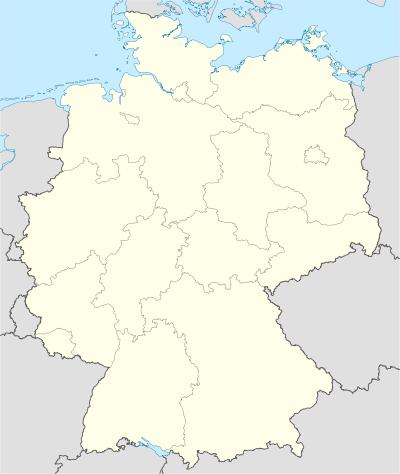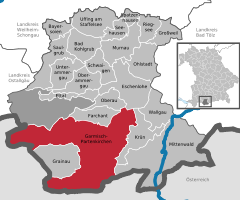Garmisch-Partenkirchen
| Garmisch-Partenkirchen | |
|
|
|
 |
|
 Garmisch-Partenkirchen
|
|
|
Location of Garmisch-Partenkirchen within Garmisch-Partenkirchen district
|
|
|---|---|
| Coordinates | |
| Administration | |
| Country | Germany |
| State | Bavaria |
| Admin. region | Upper Bavaria |
| District | Garmisch-Partenkirchen |
| Mayor | Thomas Schmid (Chr.Soziales Bündnis/Bürger für GAP e.V.) |
| Basic statistics | |
| Area | 205.66 km2 (79.41 sq mi) |
| Elevation | 708 m (2323 ft) |
| Population | 25,953 (31 December 2009)[1] |
| - Density | 126 /km2 (327 /sq mi) |
| Other information | |
| Time zone | CET/CEST (UTC+1/+2) |
| Licence plate | GAP |
| Postal code | 82467 |
| Area code | 08821 |
| Website | www.garmisch-partenkirchen.de |
Garmisch-Partenkirchen is a resort town in Bavaria, southern Germany. It is the administrative centre of the district of Garmisch-Partenkirchen, in the Oberbayern region, and the district is on the border with Austria.
Contents |
History
Garmisch and Partenkirchen were separate towns for many centuries, and still maintain quite separate identities.
Partenkirchen originated as the Roman town of Partanum on the trade route from Venice to Augsburg and is first mentioned in the year A.D. 15. Its main street, Ludwigsstrasse, follows the original Roman road.
Garmisch is first mentioned some 800 years later as Germaneskau ("German District"), suggesting that at some point a Teutonic tribe took up settlement in the western end of the valley.
The valley came under the rule of the Bishop of Freising and was governed by a bishop's representative known as a Pfleger (caretaker or warden) from Werdenfels Castle on a cliff north of Garmisch.
The discovery of America at the turn of the 16th century led to a boom in shipping and a sharp decline in overland trade, which plunged the region into a centuries-long economic depression. The valley floor was swampy and difficult to farm. Bears, wolves and lynxes were a constant threat to livestock. The population suffered from periodic epidemics, including several serious outbreaks of bubonic plague. Adverse fortunes from disease and crop failure occasionally led to witch hysteria. Most notable of these were the notorious trials and executions of 1589-1596, in which 63 victims — more than 10 percent of the population at the time — were burned at the stake or garroted.
Werdenfels Castle, where the accused were held, tried and executed, became an object of superstitious horror and was abandoned in the 17th century. It was largely torn down in the 1750s and its stones used to build the baroque Neue Kirche (New Church) on Marienplatz, which was completed in 1752. It replaced the nearby Gothic Alte Kirche (Old Church), parts of which predated Christianity and may originally have been a pagan temple. Used as a storehouse, armory and haybarn for many years, it has since been re-consecrated. Some of its medieval frescoes are still visible.
Garmisch and Partenkirchen remained separate until their respective mayors were forced by Adolf Hitler to combine the two market towns in 1935 in anticipation of the 1936 Winter Olympic games. Today, the united town is casually (but incorrectly) referred to as Garmisch, much to the dismay of Partenkirchen's residents. Most visitors will notice the slightly more modern feel of Garmisch while the fresco-filled, cobblestoned streets of Partenkirchen offer a glimpse into times past. Early mornings and late afternoons in pleasant weather often find local traffic stopped while the dairy cows are herded to and from the nearby mountain meadows.

Transportation
The town is served by Federal Highway 2 as a continuation of the A95 Autobahn (motorway), which ends at Eschenlohe 16 km north of the city. Garmisch-Partenkirchen has railway connections to Munich, Innsbruck, Reutte and to the Zugspitze, the highest mountain in Germany (2,961 m high). The views of the majestic peak from the town are especially spectacular and several accessible hiking trails cover both the lower and higher elevations.
Sports
In 1936 it was the site of the Winter Olympic Games. Traditionally, a ski jumping contest is held in Garmisch-Partenkirchen on New Year's Day, as a part of the Four Hills Tournament (Vierschanzen-Tournee). A variety of Ski World Cup Races are also held here, usually on the Kandahar Track outside town. The 1978 Alpine World Ski Championships were organized in Garmisch and the 2011 Alpine World Ski Championships are to be held there as well.
Garmisch-Partenkirchen is also a favored holiday spot for skiing, snowboarding, and hiking, having some of the best skiing areas (Garmisch Classic and Zugspitze) in Germany.
.jpg)
It was also announced on December 7, 2007 that Garmisch-Partenkirchen will put in a bid to host the 2018 Winter Olympics together with partner candidates Munich and Schönau am Königsee (near Berchtesgaden).
Public institutions
The George C. Marshall European Center for Security Studies[2] is also located in Garmisch-Partenkirchen. The Marshall Center is an internationally funded and mostly U.S.-staffed learning and conference center for governments from around the world, but primarily from the former Soviet Union and Eastern European countries. It was established in June 1993, replacing the U.S. Army Russian Institute. Near to the Marshall Center is the American Armed Forces Recreation Centers (Edelweiss Lodge and Resort) in Garmisch that serves U.S. and NATO military and their families. A number of U.S. troops and military civilians are still stationed in the town to provide logistic support to the Marshall Center and Edelweiss Recreation Center.
Notable Persons
- Michael Ende, author of The Neverending Story
- Magdalena Neuner, biathlete
- Maria Riesch, alpine skier
- Susanne Riesch, alpine skier
- Richard Strauss, composer.
Points of interest
South of Partenkirchen is the Partnach Gorge[3], where the Partnach River surges spectacularly through a narrow, mile-long gap between high limestone cliffs. The Zugspitze (local name 'Zugspitz') is south of Garmisch near the village of Grainau. The tallest mountain in Germany, it actually straddles the border with Austria. Also overlooking Garmisch-Partenkirchen is Germany's fourth-highest mountain, the Leutasch Dreitorspitze ('Three-Gate Peak', a name derived from its triple summit).
The King's House on Schachen, a small castle built for Ludwig II of Bavaria, is also located in the mountains south of Garmisch-Partenkirchen. Its grounds contain the Alpengarten auf dem Schachen, an alpine botanical garden.
References
- ↑ "Fortschreibung des Bevölkerungsstandes" (in German). Bayerisches Landesamt für Statistik und Datenverarbeitung. 31 December 2009. https://www.statistikdaten.bayern.de/genesis/online/online?sequenz=statistiken&selectionname=12411.
- ↑ Marshall European Center for Security Studies
- ↑ "Partnach Gorge". Official Website of Garmisch-Partenkirchen. Garmisch-Partenkirchen.de. 2008. http://www.garmisch-partenkirchen.de/en/57fffb4d-d7ab-67d6-de39-e4c7c5881ab0.html. Retrieved 2008-08-23.
External links
- Official website
- Alpine Ski Maps.com - winter map of Garmisch-Partenkirchen area
- Richard-Strauss-Institut (German)
- Richard-Strauss-Festival (German)
- Virtual Tour through Garmisch-Partenkirchen (German)
|
|||||
|
|||||||
